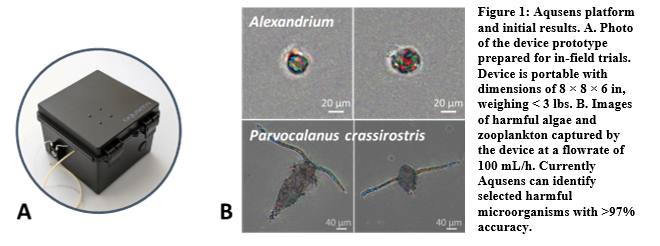HIGH THROUGHPUT MONITORING OF WATER SAMPLES FOR AUTOMATED DETECTION OF HARMFUL ALGAE AND SEA LICE
Aquaculture is the fastest growing food production sector globally and is projected to increase to 109 million tons by 2030. This significant growth is due in part to the global demand driven by recognition of the significant nutritional value of seafood and higher revenue potential for farmers and producers. Aquaculture farming is also generally less detrimental on the environment than traditional livestock production. At the same time, in comparison with other livestock industries, aquaculture is significantly behind in terms of technology innovation. However, one of the most significant challenge is to mitigate the effects of diseases that are leading to significant production losses. Most diseases are caused by parasites (such as sea lice), harmful algae, etc. Currently, the water samples are collected manually at the farm and then analyzed by trained technicians in a laboratory, often centralized, using conventional lens-based microscopes. The current approach is expensive, laborious, time consuming and limiting scalability of operations. Furthermore, due to the delays associated with conventional sample analysis, even if a disease agent is detected, it is often too late to apply risk mitigation strategies and the response shifts towards using one of the treatment options mentioned above or pre-mature harvesting.
With support from the National Science Foundation, Lucendi is responding to this urgent and unmet market need by developing an automated and cost-effective Aqusens platform. Using deep learning, Aqusens provides persistent monitoring and early identification of pathogenic microorganisms, such as sea lice and dangerous algae at a throughput of >100 mL/h (1-5 L/h for larger objects, like sea lice). The device does not require any sample pre-processing or labeling, and can detect and image ~99% of all objects (sized 4 µm - 1 mm) in water samples. This will empower aquaculture experts to apply risk mitigation and protection strategies to avoid crop loss. Fig. 1A shows the current version of the device that is portable and can be used in-field. Fig. 1B shows Aqusens images of harmful algae and of a zooplankton used as fish feed. In experimental trials we have demonstrated classification accuracy of >97% in identifying harmful microorganisms and are currently working with partners on field trials. We are interested in new partnerships and collaborations and open for trials and demonstration opportunities.
